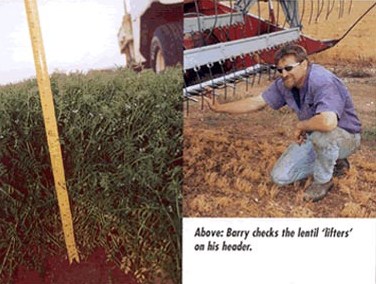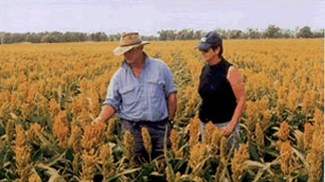Recent Newsletters
Season 2004 | Page 3
 |
||||||||
| ||||||||
When the lentils are as high as an elephant's eyeWell, it's time again to review the annual saga of Barry Lutze, 'Gwendom', near Ardrossan on South Australia's Yorke Peninsula. Our interest is not just because of his dashing good looks but also because he is now in his eighth season of growing crops with R.U.M. This means that every paddock on his property has now been well sprayed with R.U.M. with the predictable benefits of above-district-average yields, premiums earned on most crops, less fertiliser usage every year, fertile bacteria-laden soil that stays put in hot, dry northerly winds, and stubble that breaks down faster than anyone else's. It also helps that Bazz is a good farmer. And the accompanying picture of last season's lentil crop is proof that he has got his act together. Now, lentils need to be carefully monitored for grey mould especially if the weather turns wet and warm. It's not unusual for some farmers to spray five or more times to keep the crop going. Why is it then that Bazz can keep his fungicide spraying to a minimum? The chemicals aren't cheap, so despite good prices for lentils, profitability can still take a battering. His 2003 Northfield lentils (pictured) were sown with 80kg/ha of MAP and 6-7L/ha R.U.M. They yielded 13 bags/acre, were No. 1 grade and didn't require cleaning. How did your's go?
Those most professional of farmers, Brian and Pam Bowman, have graced these pages before. Their sorghum crops at 'Shingle Hut' in the Dunedoo district can be seen from The Golden Highway that runs from Singleton in the Hunter Valley to Dubbo in central NSW. It's not unusual for 'roadside farmers' to ask them if their sorghum is irrigated, only to receive the reply, "Nope, she's dryland mate." And very dryland at that. Plenty of days over 40 degrees C in January and February had the November-sown crop of Buster needing a drink until a good 160-point downpour at the end of February slaked the thirst. Not a lot of rain but enough to help fill the crop. Brian had sown his sorghum at a rate of 2.2 kgs/ha (50,000 seeds/ha). Crop nutrition included 40 kgs/ha Starter Z, 10L/ha R.U.M., and the trace elements Zinc, Boron and Calcium in liquid form. No urea was used and the photographic evidence is the proof that the crop progressed very nicely without it, thank you. Yield was 6 tonnes/ha grain and 2 tonnes/ha hay. The Bowman's also grew some impressive Taipan oats last year. Grown with three 5L/ha applications of R.U.M. and 25 kgs/ha of Starter, their cattle grazed at 1 head/acre right through 'til November. The oats were a very healthy dark green throughout. And a progress report on the Bowman's paulownia plantation reveals that a mixture of R.U.M. and a high-potassium liquid through the fertigator has the 4,000 trees going extremely well. As Brian said, "I don't know how or what the R.U.M. does but nothing else can help grow a crop like it." And when a farmer like Brian Bowman says it, you'd better believe it.
Brian and Pam Bowman appreciate their R.U.M.-grown Buster sorghum
|
||||||||
 |
||||||||









